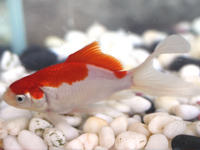 |
| Wanju Fish |
| |
|
|
|
|
 |
 |
| |
 |
 |
| Goldfish |
 |
|
 |
Carassius auratus |
| |
|
| |
|
| |
|
| |
|
| |
|
| |
|
| |
|
|
|
Goldfish (Carassius auratus) are small ornamental freshwater fish that are commonly kept as pets. Goldfish were one of the earliest breed of fish to be domesticated and are still one of the most commonly kept fish in aquariums and outdoor water gardens.
Goldfish were originally domesticated from the Prussian carp (Carassius gibelio), a dark greyish brown carp native to Asia. It was first bred for color in China over 1,000 years ago. Due to selective breeding, goldfish have been developed into many distinct breeds and are now found in various colors, color patterns, forms and sizes far different from those of the original domesticated carp.
History
In ancient China, various species of carp (collectively known as Asian carps) had been domesticated and reared as food fish for thousands of years. Some of these normally gray or silver species have a tendency to produce red, orange or yellow color mutations; this was first recorded in the Jin Dynasty (265–420).
During the Tang Dynasty (618–907), it was popular to raise carp in ornamental ponds and watergardens. Due to a natural genetic mutation, some of these carp displayed gold (actually yellowish orange) rather than silver coloration. People began to breed the gold variety instead of the silver variety, and began to display them in small containers. The fish were not kept in the containers permanently, but would be kept in a larger body of water, such as an outdoor pond, and only for special occasions at which guests were expected would they be moved to the much smaller container.
In 1162, the Empress of the Song Dynasty ordered the construction of a pond to collect the red and gold variety of those carp. By this time, people outside the imperial family were forbidden to keep goldfish of the gold (yellow) variety, yellow being the imperial color. This is probably the reason why there are more orange goldfish than yellow goldfish, even though the latter are genetically easier to breed.
The occurrence of other colors (apart from red and gold) was first recorded in 1276. The first occurrence of fancy tailed goldfish was recorded in the Ming dynasty. In 1502, goldfish were introduced to Japan, where the Ryukin and Tosakin varieties were developed. In 1611, goldfish were introduced to Portugal and from there to other parts of Europe.
During the 1620s, goldfish were highly regarded in Southern Europe because of their metallic scales, and were known to symbolize good luck and fortune. It became tradition for married men to give their wives a goldfish on their year anniversary, as a symbol for the prosperous years to come. This tradition quickly died, as goldfish became more available around Europe, thus losing their sacred status.[citation needed] Goldfish were first introduced to North America around 1850 and quickly became popular in the United States.
The wild form of the goldfish is the Prussian carp (Carassius gibelio). Some sources claim the Crucian carp (Carassius carassius) as the wild version of the goldfish. While they are closely related, they can be differentiated by the following characteristics:
C. auratus have a more pointed snout while the snout of a C. carassius is well rounded.
The wild form of the Goldfish C. gibelio often has a grey/greenish color, while crucian carps are always golden bronze.
Juvenile crucian carp have a black spot on the base of the tail which disappears with age. In C. auratus this tail spot is never present.
C. auratus have fewer than 31 scales along the lateral line while crucian carp have 33 scales or more.
Varieties
The Common, Comet, and Shubunkin varieties of goldfish are similar to wild carp (except for colour). They are hardy and can grow to a large size. Other more fancy varieties have been developed.
The main fancy varieties are: Black Moor, Bubble eye, Butterfly tail, Calico, Celestial eye, Fantail, Lionchu, Lionhead, Oranda, Panda Moor, Pearlscale, Pompom, Ranchu, Ryukin, Telescope eye, and Veiltail. Rare fancy varieties include: Tosakin or curly fantail, Jikin or peacock tail, Shukin, Tamasaba or sabao, Meteor goldfish, Egg-fish goldfish, Curled-gill goldfish or reversed-gill goldfish, Mirror-scale goldfish.
|
|
| |
|
|
| |
| |
| |
| |
|
|
